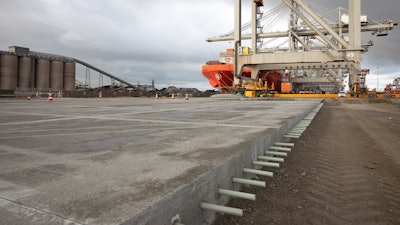Innovative Composites in Modern Building Projects
Innovative Composites in Modern Building Projects
Blog Article
Opening the Environmental Advantages of Recycled Composites in Building And Construction and Style
In the realm of building and design, the usage of recycled composites holds considerable guarantee for improving sustainability methods and minimizing ecological effect. The shift towards a much more sustainable future in these industries hinges on opening the complete possibility of recycled compounds.

Environmental Impact Reduction
The decrease of ecological impact through making use of recycled compounds in building and construction and style plays an essential role in sustainable practices. By integrating recycled compounds right into building products, the building industry can significantly lower its carbon footprint and contribute to an extra green future. These lasting materials, made from repurposed plastics, timber fibers, or other recycled components, provide a practical alternative to traditional building and construction materials without endangering on high quality or sturdiness.
Recycled composites aid divert waste from land fills and lower the requirement for removing raw materials, hence saving all-natural resources. In addition, the manufacturing process of these compounds frequently eats less power and discharges fewer greenhouse gases compared to generating virgin products (composites). This shift in the direction of using recycled compounds not only decreases environmental injury but also promotes a round economic climate by urging the reuse of products that would certainly or else be discarded
Waste Minimization
With an emphasis on reducing waste in building and construction and design, the combination of recycled compounds offers a sustainable option to reduce environmental impact. Waste minimization is a critical aspect of sustainable methods, and the usage of recycled compounds presents a chance to achieve this objective effectively. By using materials that have currently offered their first purpose, such as recycled plastics or recovered timber fibers, the building and construction and design industries can considerably minimize the quantity of waste produced and sent out to garbage dumps.
Recycled composites have the prospective to draw away significant quantities of waste from typical disposal methods, contributing to a more circular economy where resources are used successfully. In addition, the production procedure of recycled compounds commonly takes in much less power and creates fewer emissions compared to virgin products, better lowering the ecological footprint of construction and design projects.
Implementing waste reduction approaches with the consolidation of recycled composites not only helps in preserving all-natural sources however also promotes an extra lasting method to structure and creating for a greener future.
Power Conservation
Including recycled composites not just lessens waste in building and design yet additionally plays a crucial duty in improving energy preservation practices within the sector. The usage of recycled compounds in building can considerably add to energy preservation with various methods. The production of virgin materials normally requires substantial power inputs, whereas using recycled compounds eats less energy, thus decreasing general power usage. Furthermore, integrating recycled compounds can add to much better their explanation insulation residential or commercial properties in structures, minimizing the demand for extreme heating or air conditioning, and consequently lowering power use for climate control. Moreover, the lightweight nature of several recycled composites can result in lighter structures, calling for much less energy for transport and installation. By advertising the usage of recycled compounds in building and layout, the industry can make significant strides in the direction of achieving energy effectiveness and lowering its carbon impact, inevitably contributing to a more sustainable built atmosphere.
Carbon Impact Reduction
Enhancing sustainability practices via the use of recycled composites in construction and design considerably decreases the carbon footprint of the sector. By including recycled materials right into the manufacturing of composites, the need for virgin sources reduces, causing reduced energy intake and greenhouse gas discharges related to traditional production processes. This decrease in carbon footprint is essential in combating environment change and advertising a much more eco-friendly technique to building and construction and style.
The carbon footprint decrease attained through the adoption of recycled composites straightens with the international push towards lasting methods and the decrease of industrial emissions. Eventually, by focusing on the assimilation of recycled compounds, the industry can make significant strides in reducing its carbon footprint and adding to a more sustainable future.
Lasting Future
The assimilation of recycled check these guys out composites in construction and style not only addresses instant environmental worries but additionally lays a solid structure for a sustainable future in the market. By incorporating recycled composites right into structure materials and items, the construction and layout sectors can significantly minimize their dependence on virgin resources, leading to a much more round economic climate. This change towards sustainability is essential for minimizing the environmental impact of typical construction methods, which usually result in high degrees of waste generation and source depletion.

Conclusion
To conclude, recycled compounds use considerable environmental benefits in construction and design by decreasing ecological impact, minimizing waste, conserving power, reducing carbon footprint, and promoting a lasting future. Accepting making use of recycled composites can contribute to a more environmentally-friendly strategy to structure and style, ultimately leading to an extra lasting and greener future for all.
The reduction of ecological effect through the usage of recycled compounds in building and design plays an essential role in lasting methods.With a focus on minimizing waste in construction Get More Info and layout, the combination of recycled composites supplies a lasting solution to lower environmental impact. By advertising the use of recycled compounds in construction and style, the industry can make substantial strides towards attaining energy performance and decreasing its carbon impact, ultimately adding to a more lasting built setting.

Report this page